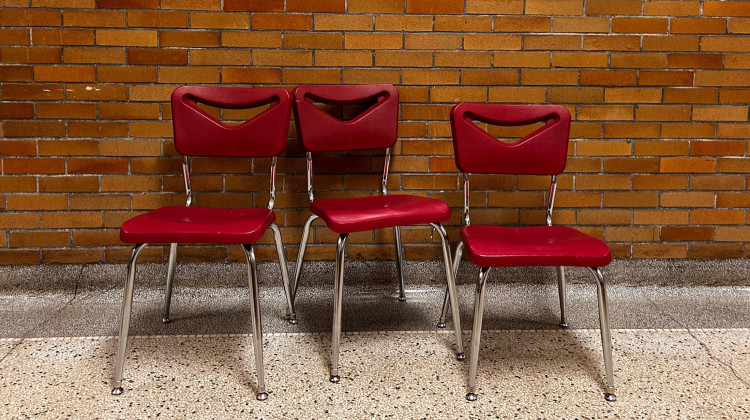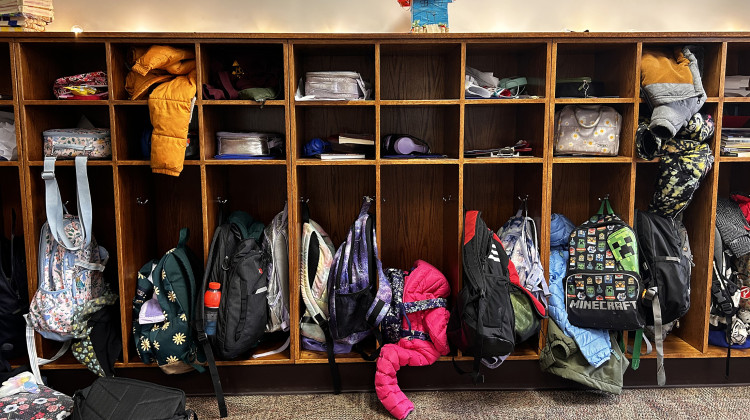
Indiana paid nearly a half-billion dollars in tuition grants to private parochial or non-religious schools in 2023-24 — 40 percent more than the previous year, according to a new state report.
Eric Weddle / WFYIEnrollment in Indiana’s private-school voucher program surged to 70,095 students in 2023-24. That’s a 31 percent increase compared to the previous year, the largest ever jump in a single year.
The state paid $439 million in tuition grants to private parochial or non-religious schools — 40 percent more than in 2022-23, according to a new state report.
The jump in voucher use comes after nearly every Indiana family became eligible to receive a voucher. A 2023 law repealed most requirements for students, such as previous enrollment in a public school, and it allows upper-income families to use public money to help pay for a private-school education. A family of four making $222,000 qualified for the Choice Scholarship Program in the recent school year.
The program's expansion is a direct result of the Indiana Statehouse Republican supermajority’s efforts to expand policies that allow families to choose what they believe is the best school, or type of school, for their children.
Researcher R. Joseph Waddington, who studies Indiana’s school choice systems, said the monumental growth is not surprising.
“Without question, a lot of the enrollment growth in the voucher program is a result of that increase in income eligibility,” said Waddington, the director of Program Evaluation and Research at University of Notre Dame.
The number of families who earn more than $200,000 a year and receive vouchers increased nearly tenfold. The report does not detail how many of these families were already attending a private school and became eligible for a voucher in the past year.
“But there is growth in other parts of the program as well, even for lower income families,” Waddington said.
The number of participating families earning less than $100,000 grew by 14 percent from year to year.
Kindergarten student participation grew by 4 percent — the most of all grades. That increase is directly tied to the repealing of the previous eligibility requirements, according to the report.
This year, 6 percent of all Indiana public and private-school students received a voucher, according to the report. Traditional public schools make up nearly 87 percent of enrollment — about half a percentage point less than the previous year.
Robert Enlow, president and CEO of EdChoice, an Indianapolis-based organization that supports vouchers, said multiple factors are leading to Indiana’s voucher growth, such as more families trying alternatives to the traditional public school system.
“With the rise in eligibility, we are naturally seeing a rise in participation in the program as many families who couldn’t quite afford it are now able to access a non-public school option,” Enlow said. “Lastly, this program has been around for almost 15 years and it is becoming more and more well known each year.”
Another reason Enlow points to is the 357 private schools now participating in the program — a 48 percent increase since 2011.
“I believe that the growth in percentage relates more to the fact that there are non-public options all over the state and that with the increase in eligibility there are simply more non-public school options in many areas of the state,” Enlow said.
The popularity of school choice friendly policies soared across the country in recent years as Republican lawmakers and advocates have pushed for adoption of vouchers and other programs. Indiana is one of 16 states with publicly funded vouchers, according to EdChoice.
But critics have long argued that voucher programs divert taxpayer funds away from public schools, shifting money into private schools that are not held to the same transparency and reporting standards as traditional public or charter schools.
As Indiana has expanded its voucher program to more high-income families, critics also contend that the state is paying tuition for students who would have attended private school without a voucher.
The report shows roughly 67.5 percent of students using a voucher have no record of prior attendance at an Indiana public school in 2023-24 — an increase of around almost 4 percentage points from the previous year.
The head of the Indiana State Teachers Association said he was "deeply concerned" about the growth of the private school voucher program in the last year.
"This expansion, extending vouchers to wealthier families, funnels public funds to those who can already afford private schools. This shift adds a financial burden on the state without reducing public school costs, undermining claims of state savings," Keith Gambill, president of the state’s largest teachers’ union, said in a statement. "Instead of helping wealthy families attend private schools at the expense of public school kids, we should be investing these tax dollars in our public schools."
Indiana Democratic state lawmakers have unsuccessfully attempted to prevent vouchers from being allocated to private schools that discriminate against lesbian, gay, bisexual, and transgender students on religious grounds. The inability to block this funding has sparked ongoing debates about the intersection of educational policy, religious freedom, and civil rights within the state.
But in recent weeks, the fight over how vouchers impact public schools is intensifying in GOP-led Texas where Republican lawmakers are battling over the financial implications.
Who is elligible?
During the 2023 legislative session lawmakers removed eight eligibility requirements. Students had been required to satisfy at least one before receiving a voucher. The change, coupled with allowing high-income families to take part, made near-universal access to private school vouchers.
Now, to be eligible for a voucher a student must have legal settlement in Indiana and be at least five years of age and less than 22 years old on October 1 of the school year. A family's household income can not be more than 400 percent of the amount to qualify for the Federal Free or Reduced Lunch Program.
For the 2024-25 school year, a family of four can earn up to $230,880 to receive a voucher, according to Indiana Department of Education guidelines.
The report
The 2023-24 academic year was the Indiana program’s 13th year. The typical student receiving a voucher is described as a White, elementary school-age girl from a household of four or five people with an income of nearly $100,000, according to the Indiana Department of Education. Indiana's median household income is about $67,000, according to the U.S. Census Bureau.
The average award amount was $6,264 and the average tuition and fees at a private school was $7,749, according to the report.
White students make up the majority of voucher users at 64 percent, an increase of about 2.5 percentage points from 2022-23. Hispanics students dropped to 17.3 percent from 19 percent. And the percentage of Black students in the program slipped by half a percentage point to 8.9 percent.
Vouchers provide 90 percent of the amount of state-funding a public school corporation receives for each student, or covers all tuition and fees — whichever is the lesser amount.
In Indiana, schools are funded by state taxes on a per-student basis. The dollars follow children to whatever schools they attend, so a traditional public school that loses a student would also lose the funding.
Fort Wayne Community Schools in Allen County have the most state dollars redirected to vouchers — $40 million, according to the report. About 3,000 students who live in the district boundaries participated in the program to attend a private school.
The two private schools with the most students and state funds from the voucher program are in Indianapolis: Heritage Christian School with 883 students and $5,697,076, and Roncalli High School with 854 students and $5,651,614.
Vouchers were initially pitched as a way to help low-income students and those in failing schools. The goal was to provide these students with the option to attend a high-quality private school. However, there has been ongoing debate about the academic benefits of vouchers and the limited access for certain students, such as those with disabilities or those who lack transportation.
In 2013, the Indiana Supreme Court upheld the use of public funds for private-school tuition.
WFYI Satehouse education reporter Rachel Fradette contributed to this story.
Eric Weddle is the WFYI education editor. Contact Eric at eweddle@wfyi.org.
 DONATE
DONATE






 Support WFYI. We can't do it without you.
Support WFYI. We can't do it without you.